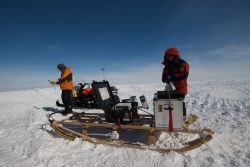Antarctica: What do scientists study at the Princess Elisabeth Station?
Every year, several scientific teams have the opportunity to stay for a few weeks or months at the Princess Elisabeth Station in Antarctica during the summer season (from November until the beginning of March). What do they do there? What do they study?
On the whole, scientists use their time in Antarctica to gather samples and make measurements to be studied closely later on, when they return to their laboratories. Throughout these series of news on the research conducted this year at the station, you will discover a whole range of different things that are sampled and studied in Antarctica by scientists with very different backgrounds. Click on the links in the text to discover pictures, videos, interviews and complementary articles.
Taking samples in Antarctica is often a feat in itself, and field trips can be dangerous. Before heading into the field, scientists thus have to complete field training and are accompanied by a field guide when in the field to avoid accidents.
The first scientific project at the station this year is called "BELgian Ice Sheet-Shelf Ice Measurements in Antarctica", code name: BELISSIMA. Lead by glaciologists Frank Pattyn and Jean-Louis Tison, this project studies the interaction between the ocean and the ice-sheet. Between November and December 2010, two teams worked in the field. The first one, lead by Frank Pattyn, measured ice thickness and tried to understand the ice flows near "ice rises". The second team went on a three-week field trip near the coast to study the ice movement through beaconing. They further did numerous drillings to sample ice cores. The entire team is now back in Europe, and eager to study all the data they collected. Read more about this research topic on SciencePoles.
Another project, SAMBA, for "Search for Antarctic Meteorites, Belgian Activities", is a Belgo-Japanese collaboration. Why do scientists hunt for meteorites in Antarctica? Not because more of them fall there, but because they are simpler to find there... There is nothing else to be found and the dark meteorites stand out against the white snow or blue ice, Vincianne Debaille explains. In some places, ice movements and erosion even accumulate them.
Meteorites are generally well-preserved in ice, even if they landed on Earth long ago. The team has been on the field for the last few weeks, and found their first meteorite on New Year's Eve. Although they are presently stuck in their mobile container on the Antarctic Plateau because of the harassing wind, they already managed to collect a hundred meteorites thus far. The scientists cautiously number and sample the meteorites without touching them to avoid contaminating the samples which will provide precious information on the solar system's or planets' evolution. Each meteorite has a different and interesting story to tell about various planets or bodies of our solar system (see the interview with Steven Goderis on EducaPoles).
For more news on the other projects currently running at the Princess Elisabeth station, follow our news on Educapoles. Meanwhile, have a look at the www.antarcticstation.org website for additional images and videos.









